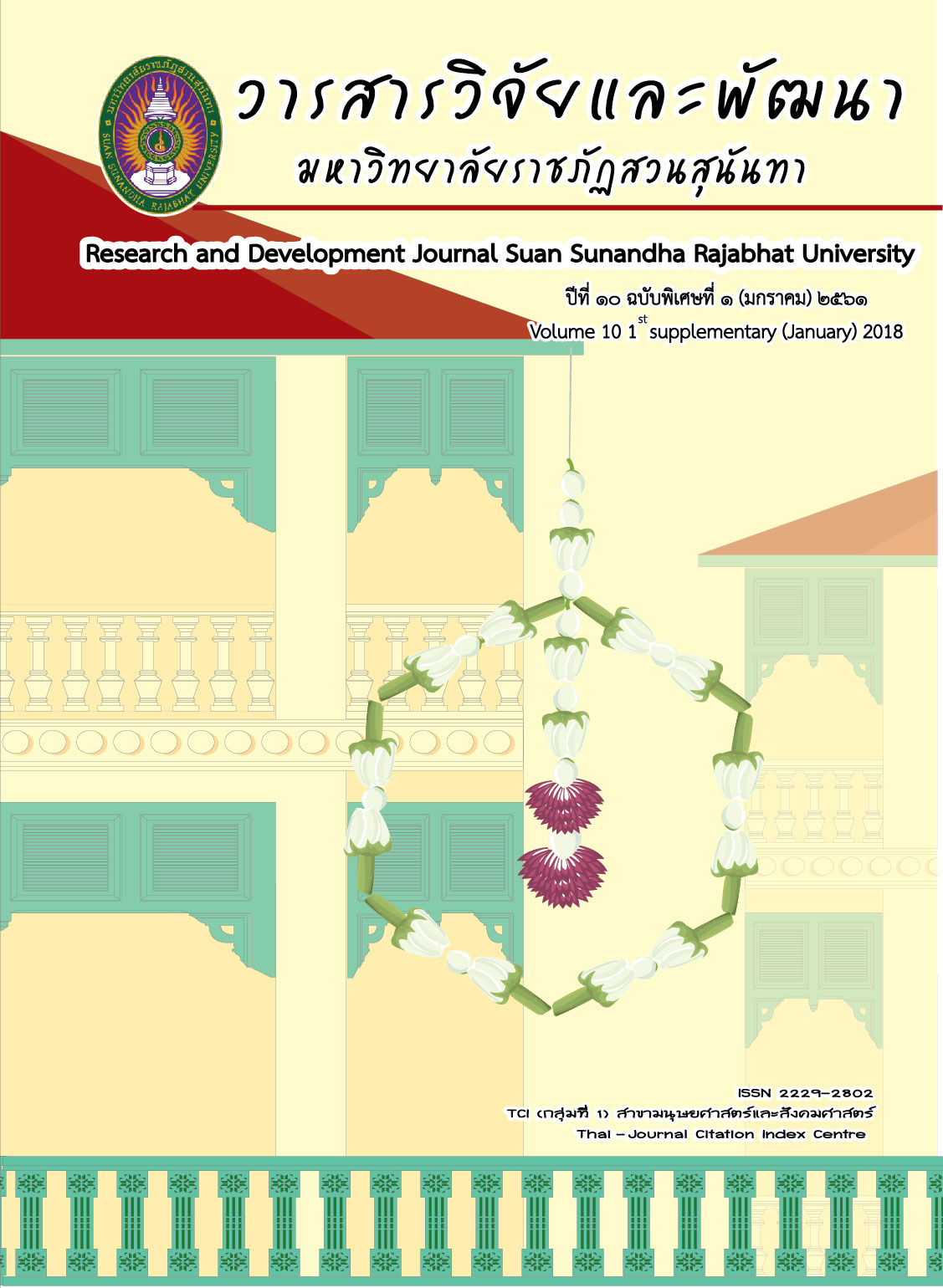ความรุนแรงไม่ใช่เรื่องสนุก: อิทธิพลของความรุนแรงและความแปลกแยก ที่มีผลต่อความสนุกของละครโทรทัศน์
DOI:
https://doi.org/10.53848/irdssru.v10i1.220506คำสำคัญ:
ความรุนแรง, ความสนุก, ความแปลกแยก, สื่อ, ละครโทรทัศน์บทคัดย่อ
เนื่องจากความสนุกของสื่อ เป็นหนึ่งในปัจจัยสำคัญที่ทำให้เกิดความสำเร็จทางการค้าของผู้ผลิตสื่อ พวกเขาจึงพยายามที่จะเพิ่มความสนุกโดยใส่ความรุนแรงลงไปในสื่อ วัตถุประสงค์ของงานวิจัยนี้ คือ เพื่อทดสอบอิทธิพลของความรุนแรงและความแปลกแยกของตัวละครที่มีต่อความสนุกในสื่อภาพยนตร์ วิธีการวิเคราะห์เนื้อหาได้ถูกใช้ในการเก็บรวบรวมข้อมูล โดยใช้กรณีศึกษาคือละครเกาหลีเรื่อง The Legend of The Blue Sea (เงือกสาวตัวร้ายกับนายต้มตุ๋น) (2016-2017) โดยละครดังกล่าวมีทั้งหมด 20 ตอน ผู้วิจัยได้เลือก 10 ตอนเพื่อนำมาใช้ในการวิเคราะห์ และเลือก 15 ฉากในแต่ละตอนมาเขียนเรียงไว้ในตารางข้อมูลซึ่งผู้วิจัยใช้ในการลงรหัสแก้ตัวแปรทั้ง 3 ตัว เมื่อการลงรหัสเสร็จสิ้น การวิเคราะห์ความถดถอยได้ถูกนำมาใช้ศึกษาอิทธิพลของตัวแปรอิสระต่อความสนุกในสื่อ ผลวิจัยแสดงให้เห็นว่า ความรุนแรงทำให้ความสนุกลดลง หากแต่ความแปลกแยกทำให้ความสนุกเพิ่มขึ้น ผู้วิจัยจึงแนะนำให้ผู้ผลิตสื่อใช้ความแปลกแยก หรือกลยุทธ์อื่น ๆ ที่ไม่ใช้ความรุนแรงในการสร้างความสนุกให้กับสื่อ
เอกสารอ้างอิง
The impact of violent video games:
An overview. Growing up fast and
furious: Reviewing the impacts of
violent and sexualised media on
children, 56-84.
Arunrangsiwed, P. (2014). Science School
Was Burned: A Case Study of Crisis
Management in Thailand.
International Journal of Social,
Behavioral, Educational, Economic,
Business and Industrial Engineering,
8(7), 2240-2248.
Arunrangsiwed, P. (2016). The Confirmation
Study of Mutant Being and Friendship
of Slash Characters in Original Media.
Silpakorn University Journal of
Social Sciences, Humanities, and
Arts, 16(1), 19-34.
Arunrangsiwed, P. & Beck, C.S. (2016).
Positive and Negative Lights of Fan
Culture. Suan Sunandha Rajabhat
University Journal of Management
Science, 3(2), 40-58.
Berns, N. S. (2004). Framing the victim:
Domestic violence, media, and
social problems. Somerset, NJ:
Transaction.
Chumbley, J., & Griffiths, M. (2006). Affect
and the computer game player: the
effect of gender, personality, and
game reinforcement structure on
affective responses to computer
game-play. CyberPsychology &
Behavior, 9(3), 308-316.
Cohen, E. L. (2014). What makes good games
go viral? The role of technology use,
efficacy, emotion and enjoyment in
players’ decision to share a prosocial
digital game. Computers in Human
Behavior, 33, 321-329.
Coker, T. R., Elliott, M. N., Schwebel, D. C.,
Windle, M., Toomey, S. L., Tortolero, S.
R., ... & Schuster, M. A. (2015). Media
violence exposure and physical
aggression in fifth-grade children.
Academic pediatrics, 15(1), 82-88.
Coyne, S. M., & Whitehead, E. (2008). Indirect
aggression in animated Disney films.
Journal of communication, 58(2),
382-395.
Cramer, P., & Mechem, M. B. (1982). Violence
in children's animated television.
Journal of applied developmental
psychology, 3(1), 23-39.
Friehe, T., Müller, H., & Neumeier, F. (2017).
The Effect of Western TV on Crime:
Evidence form East Germany. Joint
Discussion Paper Series in
Economics. Germany: The Universities
of Marburg Press.
Gray, J., Sandvoss, C., & Harrington, L. (2007).
Why study fans? In Fandom Identities
and Communities in a Mediated
World. NYU Press, pp. 1-18.
Hagenauer, G., & Hascher, T. (2014). Early
adolescents' enjoyment experienced
in learning situations and its relation to
student achievement. Journal of
Education and Training Studies, 2(2),
20-30.
Helfgott, J. B. (2015). Criminal behavior and
the copycat effect: Literature review
and theoretical framework for
empirical investigation. Aggression
and violent behavior, 22, 46-64.
Jong, B. S., Lai, C. H., Hsia, Y. T., Lin, T. W., &
Lu, C. Y. (2013). Using game-based
cooperative learning to improve
learning motivation: A study of online
game use in an operating systems
course. IEEE Transactions on
Education, 56(2), 183-190.
Joyce, S. N., & Martinez, M. (2017). From
Social Merchandising to Social
Spectacle: Portrayals of Domestic
Violence in TV Globo’s Prime-Time
Telenovelas. International journal of
communication, 11, 220–236.
Krahé, B., Busching, R., & Möller, I. (2012).
Media violence use and aggression
among German adolescents:
Associations and trajectories of change
in a three-wave longitudinal study.
Psychology of Popular Media
Culture, 1(3), 152-166.
Krakowiak, K. M. ( 2008). When good
characters do bad things examining
the effect of moral ambiguity on
enjoyment (Doctoral dissertation,
Pennsylvania State University, August
2008).
Leavenworth, M. L. (2009). Lover revamped:
sexualities and romance in the black
dagger brotherhood and slash fan
fiction. Extrapolation, 50(3), 442-462.
Mega, C., Ronconi, L., & De Beni, R. (2014).
What makes a good student? How
emotions, self-regulated learning, and
motivation contribute to academic
achievement. Journal of Educational
Psychology, 106(1), 121.
Meschoulam, M., de Benito, C., Blumenkron,
C., Muhech, A., Naanous, T., Ramírez,
A., & Quintanilla, S. (2017). Mass
Media, Violence, and Peacebuilding: A
Qualitative Study in Mexico.
International Journal of Peace
Studies, 22(1), 1-20.
Raney, A. A., & Depalma, A. J. (2006). The
effect of viewing varying levels and
contexts of violent sports
programming on enjoyment, mood,
and perceived violence. Mass
Communication & Society, 9(3), 321-
338.
Weaver, A. J., Jensen, J. D., Martins, N.,
Hurley, R. J., & Wilson, B. J. (2011).
Liking violence and action: An
examination of gender differences in
children's processing of animated
content. Media Psychology, 14(1), 49-
70.
Weber, R., Tamborini, R., Lee, H. E., & Stipp,
H. (2008). Soap opera exposure and
enjoyment: A longitudinal test of
disposition theory. Media
Psychology, 11(4), 462-487.
ดาวน์โหลด
เผยแพร่แล้ว
รูปแบบการอ้างอิง
ฉบับ
ประเภทบทความ
สัญญาอนุญาต
บทความที่ได้รับการตีพิมพ์เป็นลิขสิทธิ์ของ สถาบันวิจัยและพัฒนา มหาวิทยาลัยราชภัฎสวนสุนันทา
ข้อความที่ปรากฏในบทความแต่ละเรื่องในวารสารวิชาการเล่มนี้เป็นความคิดเห็นส่วนตัวของผู้เขียนแต่ละท่านไม่เกี่ยวข้องกับมหาวิทยาลัยราชภัฎสวนสุนันทา และคณาจารย์ท่านอื่นๆในมหาวิทยาลัยฯ แต่อย่างใด ความรับผิดชอบองค์ประกอบทั้งหมดของบทความแต่ละเรื่องเป็นของผู้เขียนแต่ละท่าน หากมีความผิดพลาดใดๆ ผู้เขียนแต่ละท่านจะรับผิดชอบบทความของตนเองแต่ผู้เดียว





